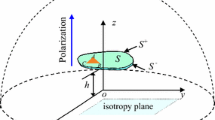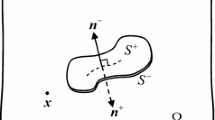Abstract
The solutions of a 3-D rectangular limited-permeable crack or two 3-D rectangular limited-permeable cracks in piezoelectric materials were given by using the generalized Almansi’s theorem and the Schmidt method. At the same time, the electric permittivity of the air inside the rectangular crack was considered. The problem was formulated through Fourier transform as three pairs of dual integral equations, in which the unknown variables are the displacement jumps across the crack surfaces. To solve the dual integral equations, the displacement jumps across the crack surfaces were directly expanded as a series of Jacobi polynomials. Finally, the effects of the electric permittivity of the air inside the rectangular crack,the shape of the rectangular crack and the distance between two rectangular cracks on the stress and electric displacement intensity factors in piezoelectric materials were analyzed.
Similar content being viewed by others
References
Sosa H, Pak YE (1990) Three-dimensional eigenfunction analysis of a crack in a piezoelectric ceramics. Int J Solids Struct 26:1–15
Mikhailov GK, Parton VS (1990) Electromagnetoelasticity. Hemisphere, New York
Suo Z, Kuo CM, Barnett DM, Willis JR (1992) Fracture mechanics for piezoelectric ceramics. J Mech Phys Solids 40:739–765
Hao TH, Shen ZY (1994) A new electric boundary condition of electric fracture mechanics and its applications. Eng Fract Mech 47:793–802
Rungamornrat J, Senjuntichai T (2009) Regularized boundary integral representations for dislocations and cracks in smart media. Smart Mater Struct 18:074010
Gao H, Zhang TY, Tong P (1997) Local and global energy rates for an elastically yielded crack in piezoelectric ceramics. J Mech Phys Solids 45:491–510
Narita K, Shindo Y (1999) Scattering of anti-plane shear waves by a finite crack in piezoelectric laminates. Acta Mech 134:27–43
Han JJ, Chen YH (1999) Multiple parallel cracks interaction problem in piezoelectric ceramics. Int J Solids Struct 36:3375–3390
Zhou ZG, Zhang PW, Wu LZ (2007) Two parallel limited-permeable Mode-I cracks or four parallel limited-permeable Mode-I cracks in the piezoelectric materials. Int J Solids Struct 44(11–12):4184–4205
Deeg WEF (1980) The analysis of dislocation, crack and inclusion problems in piezoelectric solids. Ph.D. thesis, Stanford University
Pak YE (1990) Crack extension force in a piezoelectric material. J Appl Mech 57:647–653
Parton VS (1976) Fracture mechanics of piezoelectric materials. Acta Astronaut 3:671–683
Hao TH (2001) Multiple collinear cracks in a piezoelectric material. Int J Solids Struct 38(50–51):9201–9208
Dascalu D, Homentcovschi D (2002) An intermediate crack model for flaws in piezoelectric solids. Acta Mech 154(1–4):85–100
Wang BL, Han JC, Du SY (2004) Applicability of the crack face electrical boundary conditions in piezoelectric mechanics. Acta Mech Solida Sin 17(4):90–296
Wang BL, Mai YW (2004) Impermeable crack and permeable crack assumptions, which one is more realistic? J Appl Mech 71(4):575–578
Soh AK, Fang DN, Lee KL (2000) Analysis of a bi-piezoelectric ceramic layer with an interfacial crack subjected to anti-plane shear and in-plane electric loading. Eur J Mech A, Solids 19:961–977
Chen MC (2003) Application of finite-part integrals to the three-dimensional fracture problems for piezoelectric media, Part I: hypersingular integral equation and theoretical analysis. Int J Fract 121:133–148
Chen MC (2003) Application of finite-part integrals to the three-dimensional fracture problems for piezoelectric media, Part II: numerical analysis. Int J Fract 121:149–161
Chen MC (2005) 3D mode I crack analysis of piezoelectric. Comput Methods Appl Mech Eng 194:957–968
Wippler K, Kuna M (2007) Crack analyses in three-dimensional piezoelectric structures by the BEM. Comput Mater Sci 39:261–266
Jaroon R, Mark EM (2008) Analysis of fractures in 3D piezoelectric media by a weakly singular integral equation method. Int J Fract 151:1–27
Chen WQ, Shioya T (1999) Fundamental solution for a penny-shaped crack in a piezoelectric medium. J Mech Phys Solids 47:1459–1475
Wang B (1992) Three-dimensional analysis of a flat elliptical crack in a piezoelectric material. Int J Eng Sci 30:781–791
Zhu BJ, Qin TY (2007) Hypersingular integral equation method for a three-dimensional crack in anisotropic electro-magneto-elastic bimaterials. Theor Appl Fract Mech 47:219–232
Shang FL, Kuna M, Abendroth M (2003) Finite element analyses of three-dimensional crack problems in piezoelectric structures. Eng Fract Mech 70:143–160
Itou S (1978) Three dimensional waves propagation in a cracked elastic solid. J Appl Mech 45:807–811
Itou S (1999) 3D dynamic stress intensity factors at three rectangular cracks in an infinite elastic medium subjected to a time-harmonic stress wave. Arch Appl Mech 69:286–298
Itou S (2001) 3D dynamic stress intensity factors around two parallel square cracks in an infinite elastic medium under impact load. Arch Appl Mech 71:53–62
Itou S (2002) Dynamic stress intensity factors around two rectangular cracks in an infinite elastic plate under impact load. Mech Res Commun 29:225–234
Chen WQ, Lee KY, Ding HJ (2004) General solution for transversely isotropic magneto-electro-thermo-elasticity and the potential theory method. Int J Eng Sci 42:1361–1379
Morse PM, Feshbach H (1958) Methods of theoretical physics. McGraw-Hill, New York, pp 828–930
Yan WF (1967) Axisymmetric slipless indentation of an infinite elastic cylinder. SIAM J Appl Math 15:219–227
Yang FQ (2001) Fracture mechanics for a Mode I crack in piezoelectric materials. Int J Solids Struct 38:3813–3830
Ding HJ, Chen B, Liang J (1996) General solutions for coupled equations for piezoelectric media. Int J Solids Struct 33(16):2283–2296
Erdelyi A (1954) Tables of integral transforms, vol 1. McGraw-Hill, New York, pp 34–89
Gradshteyn IS, Ryzhik IM (1980) Table of integral, series and products. Academic Press, New York, pp 1035–1037
Noda NA, Kihara TA (2002) Variation of the stress intensity factor along the front of a 3-D rectangular crack subjected to mixed-mode load. Arch Appl Mech 72:599–614
Feng WJ, Li YS, Xu ZH (2009) Transient response of an interfacial crack between dissimilar magnetoelectroelastic layers under magnetoelectromechanical impact loadings: mode-I problem. Int J Solids Struct 46:3346–3356
Author information
Authors and Affiliations
Corresponding author
Rights and permissions
About this article
Cite this article
Zhou, ZG., Liu, JY. & Wu, L.Z. Basic solutions of a 3-D rectangular limited-permeable crack or two 3-D rectangular limited-permeable cracks in piezoelectric materials. Meccanica 47, 109–134 (2012). https://doi.org/10.1007/s11012-010-9418-5
Received:
Accepted:
Published:
Issue Date:
DOI: https://doi.org/10.1007/s11012-010-9418-5




